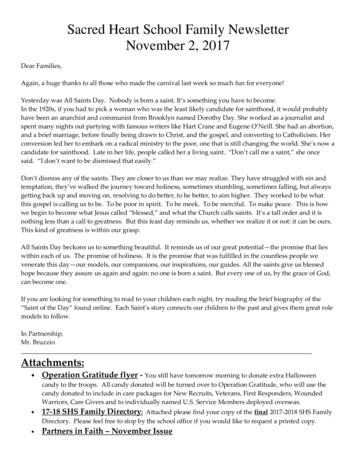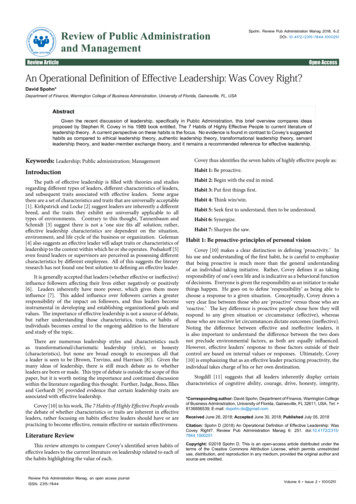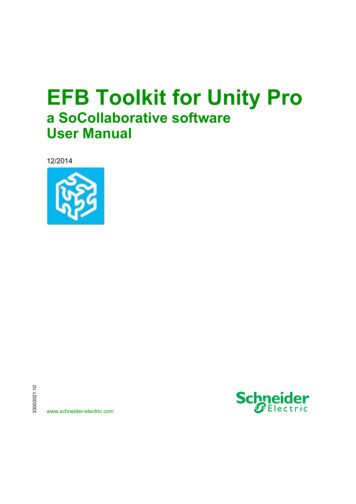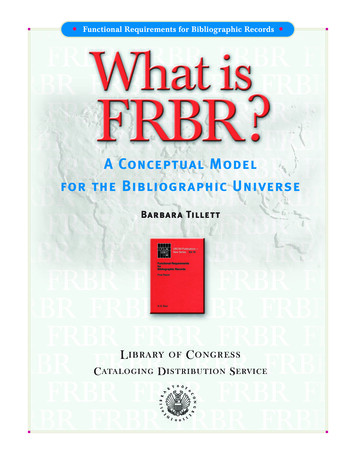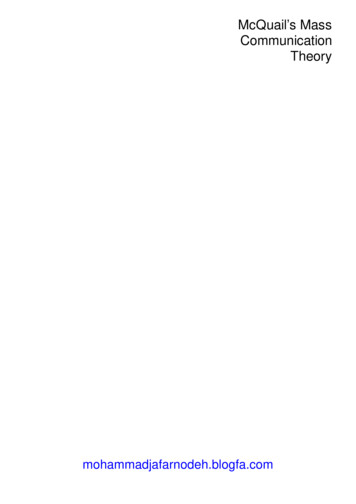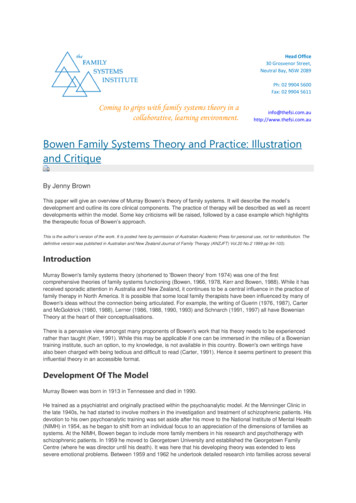
Transcription
Head Office30 Grosvenor Street,Neutral Bay, NSW 2089Ph: 02 9904 5600Fax: 02 9904 5611Coming to grips with family systems theory in acollaborative, learning m.auBowen Family Systems Theory and Practice: Illustrationand CritiqueBy Jenny BrownThis paper will give an overview of Murray Bowen’s theory of family systems. It will describe the model’sdevelopment and outline its core clinical components. The practice of therapy will be described as well as recentdevelopments within the model. Some key criticisms will be raised, followed by a case example which highlightsthe therapeutic focus of Bowen’s approach.This is the author’s version of the work. It is posted here by permission of Australian Academic Press for personal use, not for redistribution. Thedefinitive version was published in Australian and New Zealand Journal of Family Therapy (ANZJFT) Vol.20 No.2 1999 pp 94-103).IntroductionMurray Bowen's family systems theory (shortened to 'Bowen theory' from 1974) was one of the firstcomprehensive theories of family systems functioning (Bowen, 1966, 1978, Kerr and Bowen, 1988). While it hasreceived sporadic attention in Australia and New Zealand, it continues to be a central influence in the practice offamily therapy in North America. It is possible that some local family therapists have been influenced by many ofBowen's ideas without the connection being articulated. For example, the writing of Guerin (1976, 1987), Carterand McGoldrick (1980, 1988), Lerner (1986, 1988, 1990, 1993) and Schnarch (1991, 1997) all have BowenianTheory at the heart of their conceptualisations.There is a pervasive view amongst many proponents of Bowen's work that his theory needs to be experiencedrather than taught (Kerr, 1991). While this may be applicable if one can be immersed in the milieu of a Boweniantraining institute, such an option, to my knowledge, is not available in this country. Bowen's own writings havealso been charged with being tedious and difficult to read (Carter, 1991). Hence it seems pertinent to present thisinfluential theory in an accessible format.Development Of The ModelMurray Bowen was born in 1913 in Tennessee and died in 1990.He trained as a psychiatrist and originally practised within the psychoanalytic model. At the Menninger Clinic inthe late 1940s, he had started to involve mothers in the investigation and treatment of schizophrenic patients. Hisdevotion to his own psychoanalytic training was set aside after his move to the National Institute of Mental Health(NIMH) in 1954, as he began to shift from an individual focus to an appreciation of the dimensions of families assystems. At the NIMH, Bowen began to include more family members in his research and psychotherapy withschizophrenic patients. In 1959 he moved to Georgetown University and established the Georgetown FamilyCentre (where he was director until his death). It was here that his developing theory was extended to lesssevere emotional problems. Between 1959 and 1962 he undertook detailed research into families across several
generations. Rather than developing a theory about pathology, Bowen focused on what he saw as the commonpatterns of all 'human emotional systems'. With such a focus on the qualitative similarities of all families, Bowenwas known to say frequently, 'There is a little schizophrenia in all of us' (Kerr and Bowen, 1988).In 1966, Bowen published the first 'orderly presentation' of his developing ideas (Bowen, 1978: xiii). Around thesame time he used his concepts to guide his intervention in a minor emotional crisis in his own extended family,an intervention which he describes as a spectacular breakthrough for him in theory and practice (Bowen, 1972 inBowen, 1978). In 1967, he surprised a national family therapy conference by talking about his own familyexperience, rather than presenting the anticipated formal paper. Bowen proceeded to encourage students towork on triangles and intergenerational patterns in their own families of origin rather than undertaking individualpsychotherapy. From this generation of trainees have come the current leaders of Bowenian Therapy, such asMichael Kerr at the Georgetown Family Center, Philip Guerin at the Center for Family Learning, Betty Carter atthe Family Institute of Westchester, and Monica McGoldrick at the [Multicultural] Family Institute of New Jersey.While the core concepts of Bowen's theory have changed little over two decades, there have been significantexpansions: the focus on life cycle stages (Carter and McGoldrick, 1980, 1988) and the incorporation of afeminist lens (Carter, Walters, Papp, Silverstein, 1988; Lerner, 1983; Bograd, 1987).The TheoryBowen's focus was on patterns that develop in families in order to defuse anxiety. A key generator of anxiety infamilies is the perception of either too much closeness or too great a distance in a relationship. The degree ofanxiety in any one family will be determined by the current levels of external stress and the sensitivities toparticular themes that have been transmitted down the generations. If family members do not have the capacityto think through their responses to relationship dilemmas, but rather react anxiously to perceived emotionaldemands, a state of chronic anxiety or reactivity may be set in place.The main goal of Bowenian therapy is to reduce chronic anxiety by1. facilitating awareness of how the emotional system functions; and2. increasing levels of differentiation, where the focus is on making changes for the self rather than ontrying to change others.Eight interlocking concepts make up Bowen's theory. This paper will give an overview of seven of these. Theeighth attempts to link his theory to the evolution of society, and has little relevance to the practice of his therapy.[However, Wylie (1991) points out in her biographical piece following Bowen's death that this interest inevolutionary process distinguishes Bowen from other family therapy pioneers. Bowen viewed himself as ascientist, with the lofty aim of developing a theory that accounted for the entire range of human behaviour and itsorigins.]1 - Emotional Fusion and Differentiation of Self2 - Triangles3 - Nuclear Family Emotional System3a. Couple Conflict3b. Symptoms in a Spouse3c. Symptoms in a Child4 - Family Projection Process5 - Emotional Cutoff6 - Multi-generational Transmission Process
7 - Sibling Positions1 - Emotional Fusion and Differentiation of Self'Fusion' or 'lack of differentiation' is where individual choices are set aside in the service of achieving harmonywithin the system.Fusion can be expressed either as:* a sense of intense responsibility for another's reactions, or* by emotional 'cutoff' from the tension within a relationship (Kerr and Bowen, 1988; Herz Brown, 1991).Bowen's research led him to suggest that varying degrees of fusion are discernible in all families. 'Differentiation',by contrast, is described as the capacity of the individual to function autonomously by making self directedchoices, while remaining emotionally connected to the intensity of a significant relationship system (Kerr andBowen, 1988). Bowen's notion of fusion has a different focus to Minuchin's concept of enmeshment, which isbased on a lack of boundary between sub-systems (Minuchin, 1974). The structural terms 'enmeshment' and'disengagement' are in fact the twin polarities of Bowen's 'fusion'. Fusion describes each person's reactions withina relationship, rather than the overall structure of family relationships. Hence, anxiously cutting off the relationshipis as much a sign of fusion as intense submissiveness. A person in a fused relationship reacts immediately (as ifwith a reflex, knee jerk response) to the perceived demands of another person, without being able to thinkthrough the choices or talk over relationship matters directly with the other person. Energy is invested in takingthings personally (ensuring the emotional comfort of another), or in distancing oneself (ensuring one's own). Thegreater a family's tendency to fuse, the less flexibility it will have in adapting to stress.Bowen developed the idea of a 'differentiation of self scale' to assist in teaching this concept. He points out thatthis was not designed as an actual instrument for assigning people to particular levels (Kerr and Bowen, 1988:97-98). Bowen maintains that the speculative nature of estimating a level of differentiation is compounded byfactors such as stress levels, individual differences in reactivity to different stressors, and the degree of contactindividuals have with their extended family. At one end of the scale, hypothetical 'complete differentiation' is saidto exist in a person who has resolved their emotional attachment to their family (ie. shifted out of their roles inrelationship triangles) and can therefore function as an individual within the family group.Bowen did acknowledge that this was a lifelong process and that 'total' differentiation is not possible to attain.2 - TrianglesBowen described triangles as the smallest stable relationship unit (Kerr and Bowen, 1988: 135). The process oftriangling is central to his theory. (Some people use the term 'triangulation', deriving from Minuchin (1974: 102),but Bowen always spoke of 'triangling'.) Triangling is said to occur when the inevitable anxiety in a dyad isrelieved by involving a vulnerable third party who either takes sides or provides a detour for the anxiety (Lerner,1988; James, 1989; Guerin, Fogarty, Fay and Kautto, 1996). An example of this pattern would be when Person Ain a marriage begins feeling uncomfortable with too much closeness to Person B. S/he may begin withdrawing,perhaps to another activity such as work (the third point of the triangle). Person B then pursues Person A, whichresults in increased withdrawal to the initial triangled-in person or activity. Person B then feels neglected andseeks out an ally who will sympathise with his/her sense of exclusion. This in turn leads to Person A feeling likethe odd one out and moving anxiously closer to Person B. Under stress, the triangling process feeds on itself andinterlocking triangles are formed throughout the system. This can spill over into the wider community, when familymembers find allies, or enemies to unite against, such as doctors, teachers and therapists.Under calm conditions it is difficult to identify triangles but they emerge clearly under stress. Triangles are linkedclosely with Bowen's concept of differentiation, in that the greater the degree of fusion in a relationship, the moreheightened is the pull to preserve emotional stability by forming a triangle. Bowen did not suggest that theprocess of triangling was necessarily dysfunctional, but the concept is a useful way of grasping the notion that theoriginal tension gets acted out elsewhere. Triangling can become problematic when a third party's involvementdistracts the members of a dyad from resolving their relationship impasse. If a third party is drawn in, the focusshifts to criticising or worrying about the new outsider, which in turn prevents the original complainants from
resolving their tension. According to Bowen, triangles tend to repeat themselves across generations. When onemember of a relationship triangle departs or dies, another person can be drawn into the same role (eg. 'villain','rescuer', 'victim', 'black sheep', 'martyr'). For example, in my own family of origin I found myself moving into therole of peacemaker after the death of my mother, who had mediated the tension between my father and brother.This ongoing triangle served to detour the anxiety that had been played out between fathers and sons in thefamily over the generations.3 - Nuclear Family Emotional SystemIn positing the 'nuclear family emotional system', Bowen focuses on the impact of 'undifferentiation' on theemotional functioning of a single generation family. He asserts that relationship fusion, which leads to triangling,is the fuel for symptom formation which is manifested in one of three categories. These are:a. couple conflict;b. illness in a spouse;c. projection of a problem onto one or more children.Each of these is expanded below.3A. COUPLE CONFLICTThe single generation unit usually starts with a dyad - a couple who, according to Bowen, will be at approximatelyequal levels of differentiation (ie. both have the same degree of need to be validated through the relationship).Bowen believed that permission to disagree is one of the most important contracts between individuals in anintimate relationship (Kerr and Bowen, 1988: 188). In a fused relationship, partners interpret the emotional stateof the other as their responsibility, and the other's stated disagreement as a personal affront to them. A typicalpattern in such emotionally intense relationships is a cycle of closeness followed by conflict to create distance,which in turn is followed by the couple making up and resuming the intense closeness. This pattern is a'conflictual cocoon' (Kerr and Bowen, 1988: 192), where anxiety is bound within the conflict cycle without spillingover to involve children. Bowen suggested the following three ways in which couple conflict can be functional fora fused relationship, in which 'each person is attempting to become more whole through the other' (Lederer andLewis, 1991).1. Conflict can provide a strong sense of emotional contact with the important other.2. Conflict can justify people's maintaining a comfortable distance from each other without feeling guilty about it.3. Conflict can allow one person to project anxieties they have about themselves onto the other, therebypreserving their positive view of self (Kerr and Bowen, 1988: 192).3B. SYMPTOMS IN A SPOUSEIn a fused relationship, where each partner looks to the other's qualities to fit his / her learned manner of relatingto significant others, a pattern of reciprocity can be set in motion that pushes each spouse's role to oppositeextremes. Drawing from his analytic background, Bowen described this fusion as 'the reciprocal side of eachspouse's transference' (Kerr and Bowen, 1988: 170). For example, what may start as an overly responsiblespouse feeling compatible with a more dependent partner, can escalate to an increasingly controlling spouse withthe other giving up any sense of contributing to the relationship. Both are equally undifferentiated in that they aredefining themselves according to the reactions of the other; however the spouse who makes the mostadjustments in the self in order to preserve relationship harmony is said by Bowen to be prone to developingsymptoms. The person who gets polarised in the under functioning position is most vulnerable to symptoms ofhelplessness such as depression, substance abuse and chronic pain. The over functioning person might also bethe one to develop symptoms, as s/he becomes overburdened by attempts to make things 'right' for others.3C. SYMPTOMS IN A CHILD
The third symptom of fusion in a family is when a child develops behavioural or emotional problems. This comesunder Bowen's fourth theoretical concept, the Family Projection Process.4 - Family Projection ProcessIn the previous two categories the couple relationship is the focus of anxiety without it significantly impacting onthe functioning of the next generation. By contrast, the family projection process describes how children developsymptoms when they get caught up in the previous generation's anxiety about relationships.The child with the least emotional separation from his/her parents is said to be the most vulnerable to developingsymptoms. Bowen describes this as occurring when a child responds anxiously to the tension in the parents'relationship, which in turn is mistaken for a problem in the child. A detouring triangle is thus set in motion, asattention and protectiveness are shifted to the child. Within this cycle of reciprocal anxiety, a child becomes moredemanding or more impaired. An example would be when an illness in a child distracts one parent from thepursuit of closeness in the marriage. As tension in the marriage is relieved, both spouses become invested intreating their child's condition, which may in turn become chronic or psychosomatic.As in all of Bowen's constructs, 'intergenerational projection' is said to occur in all families in varying degrees.Many intergenerational influences may determine which child becomes the focus of family anxiety and at whatstage of the life cycle this occurs. The impact of crises and their timing also influences the vulnerability of certainchildren. Bowen viewed traumatic events as significant in highlighting the family processes rather than as actually'causing' them.5 - Emotional CutoffBowen describes 'emotional cutoff' as the way people manage the intensity of fusion between the generations. A'cutoff' can be achieved through physical distance or through forms of emotional withdrawal. Bowen distinguishesbetween 'breaking away' from the family and 'growing away' from the family. 'Growing away' is viewed as part ofdifferentiation - adult family members follow independent goals while also recognising that they are part of theirfamily system. A 'cutoff' is more like an escape; people 'decide' to be completely different to their family of origin.While immediate pressure might be relieved by cutoff, patterns of reactivity in intense relationships remainunchanged and versions of the past, or its mirror image, are repeated. Bowen proposes that:If one does not see himself as part of the system, his only options are either to get others to change or towithdraw. If one sees himself as part of the system, he has a new option: to stay in contact with others andchange self (Kerr and Bowen, 1988: 272-273).'Cutoffs' are not always dramatic rifts. An example of a covert emotional cutoff would be one family membermaintaining an anxious silence in the face of another's anger. The pull to restore harmony overwhelms the abilityto stay in contact with the issue that has been raised.A central hypothesis of Bowen's theory is that the more people maintain emotional contact with the previousgeneration, the less reactive they will be in current relationships. Conversely, when there are emotional cutoffs,the current family group can experience intense emotional pressure without effective escape valves. This familytension is like 'walking on eggshells', as issues which remain unresolved from the cutoff are carefully avoided.Triangling provides a detour, as family members enlist the support of others for their own position in relation tothe cutoff.6 - Multi-generational Transmission ProcessThis concept of Bowen's theory describes how patterns, themes and positions (roles) in a triangle are passeddown from generation to generation through the projection from parent to child which was described earlier. Theimpact will be different for each child depending on the degree of triangling they have with their parents.Bowen's focus on at least three generations of a family when dealing with a presenting symptom is certainly atrademark of his theory. The attention to family patterns over time is not just an evaluative tool, but anintervention that helps family members get sufficient distance from their current struggle with symptoms to see
how they might change their own part in the transmission of anxiety over the generations. As Monica McGoldrick(1995: 20) writes in applying Bowenian concepts:By learning about your family and its history and getting to know what made family members tick, how theyrelated, and where they got stuck, you can consider your own role, not simply as victim or reactor to yourexperiences but as an active player in interactions that repeat themselves.7 - Sibling PositionsEmploying Walter Toman's (1976) sibling profiles, Bowen considered that sibling position could provide usefulinformation in understanding the roles individuals tend to take in relationships. For example, Toman's profilesdescribe eldest children as more likely to take on responsibility and leadership, with younger siblings morecomfortable being dependent and allowing others to make decisions. Middle children are described as havingmore flexibility to shift between responsibility and dependence and 'only' children are seen as being responsible,and having greater access to the adult world. Bowen noted that these generalised traits are not universallyapplicable and that it is possible for a younger sibling to become the 'functional eldest'. Bowen was especiallyinterested in which sibling position in a family is most vulnerable to triangling with parents. It may be that a parentidentifies strongly with a child in the same sibling position as their own, or that a previous cross generationaltriangle (eg. an eldest child aligned with a grandparent against a parent) may be repeated. If one sibling in theprevious generation suffered a serious illness or died, it is more likely that the child of the present generation inthe same sibling position will be viewed as more vulnerable and therefore more likely to detour tensions from theparental dyad.Helping the client understand and think beyond the limitations of their own sibling position and role is a goal ofBowenian family of origin work. Clients are encouraged to consider how assumptions about relationships arefuelled by their sibling role experience. As with other aspects of Bowen's theory, the impact of gender andethnicity on sibling role is not considered. For example, there is no exploration of how a family's ethnicityinfluences which birth order position and which gender is more valued, or how the gender of any sibling positiontends to influence whether the role is primarily relational (female), or task oriented (male).The Model In Clinical PracticeBowen's is not a technique focused model which incorporates specific descriptions of how to structure therapysessions. The goal of therapy is to assist family members towards greater levels of differentiation, where there isless blaming, decreased reactivity and increased responsibility for self in the emotional system. Perhaps the mostdistinctive aspects of Bowen's therapy are his emphasis on the therapist's own family of origin work, the centralrole of the therapist in directing conversation and his minimal focus on children in the process of therapy.Bowen views therapy in three broad stages.1.Stage one aims to reduce clients' anxiety about the symptom by encouraging them to learn how thesymptom is part of their pattern of relating.2.Stage two focuses adult clients on 'self' issues so as to increase their levels of differentiation. Clients arehelped to resist the pull of what Bowen termed the 'togetherness force' in the family (Bowen, 1971 inBowen, 1978: 218).3.In the latter phases of therapy, adult clients are coached in differentiating themselves from their family oforigin, the assumption being that gains in differentiation will automatically flow over into decreased anxietyand greater self-responsibility within the nuclear family system.Clinical Practice : The Role of the TherapistThe role of the therapist is to connect with a family without becoming emotionally reactive. Emphasis is given tothe therapist maintaining a 'differentiated' stance. This means that the therapist is not drawn into an overresponsible / under responsible reciprocity in attempts to be helpful. A therapist position of calm and interested
investigation is important, so that the family begins to learn about itself as an emotional system. Bowen instructstherapists to move out of a healing or helping position, where families passively wait for a cure, 'to getting thefamily into position to accept responsibility for its own change' (Bowen, 1971 in Bowen, 1978: 246).Bowen warns of the problems of therapists losing sight of their part in the system of interactions, where they maybe inducted into a mediating role in a triangle with the family. Hence there is a high priority given tounderstanding and making changes within the therapist's own family of origin. In training, the emphasis is on thetrainees' level of differentiation, and not on therapeutic technique. The therapist's resolution of family of originissues is reflected in the:.ability to be in emotional contact with a difficult, emotionally charged problem and not feel compelled to preachabout what others should do, not rush in to fix the problem and not pretend to be detached by emotionallyinsulating oneself (Kerr and Bowen, 1988: 108).Clinical Practice : Therapist ActivityThe therapist is active in directing the therapeutic conversation. Enactments are halted so as to prevent theescalation of clients' anxiety. Clients are asked to talk directly to the therapist so that other family members can"listen and 'really hear' without reacting emotionally, for the first time in their lives together" (Bowen, 1971 inBowen, 1978: 248). Bowen himself would avoid couple interaction in the room and concentrate on interviewingone spouse in the presence of the other. Bowen clearly avoided asking for emotional responses, which he sawas less likely to lead to differentiation of self, preferring mostly to ask for 'thoughts', 'reactions' and 'impressions'(Bowen, 1971, in Bowen, 1978: 226). He called this activity 'externalizing the thinking of each client in thepresence of the other' (Bowen, 1975 in Bowen, 1978: 314).Clinical Practice : Children in Bowen's TherapyA surprising feature of Bowen's family therapy is his tendency to minimise the involvement of children. WhileBowen might include children in the beginning stage of therapy, he would soon dismiss them, focusing on theadults as the most influential members of a family system (Bowen, 1975 in Bowen, 1978: 298). Excluding a childfrom therapy responsibility is viewed as a detriangling manoeuvre. When parents cannot use the child as a'triangle person' for issues between them, and the therapist resists taking the replacement role in the triangle,parents can begin differentiating their respective selves from one other.Clinical Practice : Family EvaluationThe beginning sessions in Bowenian therapy focus on information gathering in order to form ideas about thefamily's emotional processes, which concurrently provides information to family members about the presentingproblem in its systemic context. The presenting problem is tracked through the history of the nuclear family andinto the extended family system. A multigenerational genogram is a useful tool for recording this information(McGoldrick and Gerson, 1985; Kerr and Bowen, 1988: 306-313). The therapist looks for clues about theemotional process of the particular family, including: patterns of regulating closeness and distance, how anxiety isdealt with in the system, what triangles get activated, the degree of adaptivity to changes and stressful events,and any signs of emotional 'cutoff'. Information collected is acknowledged to be extremely subjective, especiallywhen extended family are discussed; but stories about past generations are viewed as useful clues to the rolespeople occupy in triangles and the tensions that remain unresolved from their families of origin. If for example, amember of the extended family is described as 'the rebel', the therapist explores what events gave rise to thislabel, who else has occupied this role across the generations and how triangles formed around family crisesinvolving 'rebellion'. Calming family members' anxiety in the early stages of therapy might involve helping them tomake connections between the development of symptoms and potent themes in a family's history. Another aimwill be to loosen the central triangle that has formed around, and maintains, the presenting problem. Teachingclients about systems concepts as they operate in their own family is part of therapy at this stage. This does notmean attempting to convince people to do things differently but to encourage family members to see beyond theirbiases so that it is possible for them to consider each person's part in the family patterns.Clinical Practice : Questions that Encourage Differentiation
The therapist asks questions that assume that the adult client can be responsible for his / her reactiveness to theother. An example would be, "How do you understand the way you seem to take your child's acting out sopersonally?" In response to such questions, family members are encouraged to take an 'I' position where theyspeak about how they view the problem, without attacking, or defending against, another family member (Bowen,1971a in Bowen, 1978: 252; Goodnow and Lim, 1997). Clients are taught to make personal statements abouttheir thoughts and feelings in order to facilitate a greater sense of responsibility in a relationship. For example, anaccusatory statement such as, 'You are so selfish to cause this much worry for your parents!', is shifted to, 'I amreally concerned that this might affect your school grades'. The parent is encouraged to 'own' their worries, ratherthan to project their anxieties through blaming statements. Developing such a 'self-focus' is said to be crucial inlowering anxiety and enabling 'person to person' relationships where each family member can think about thepart they play in problematic interactions.Clinical Practice : Creating a Multigenerational LensBowen's multigenerational model goes beyond the view that the past influences the present, to the view thatpatterns of relating in the past continue in the present family system (Herz Brown, 1991). Hence the therapistuses questions to encourage clients to think about the connection between their present problem and the waysprevious generations have dealt with similar relationship issues. For example, if the onset of a symptom followeda death in the family, the therapist asks about how grief has been dealt with in previous generations. Questionsseek to uncover family belief systems as well as the way relationships have shifted in respon
definitive version was published in Australian and New Zealand Journal of Family Therapy (ANZJFT) Vol.20 No.2 1999 pp 94-103). Introduction Murray Bowen's family systems theory (shortened to 'Bowen theory' from 1974) was one of the first comprehensive theories of family systems functionin



